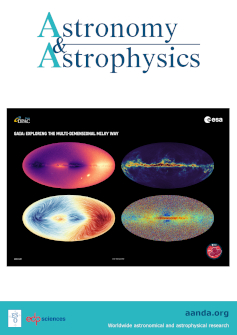Mind the trap
IF 5.4
2区 物理与天体物理
Q1 ASTRONOMY & ASTROPHYSICS
引用次数: 0
Abstract
Aims. The ability of bulk ices (H2O, CO2) to trap volatiles has been well studied in any experimental sense, but largely ignored in protoplanetary disk and planet formation models as well as the interpretation of their observations. We demonstrate the influence of volatile trapping on C/O ratios in planet-forming environments.Methods. We created a simple model of CO, CO2, and H2O snowlines in protoplanetary disks and calculated the C/O ratio at different radii and temperatures. We included a trapping factor, which partially inhibits the release of volatiles (CO, CO2) at their snowline and releases them instead, together with the bulk ice species (H2O, CO2). Our aim has been to assess its influence of trapping solid-state and gas phase C/O ratios throughout planet-forming environments.Results. Volatile trapping significantly affects C/O ratios in protoplanetary disks. Variations in the ratio are reduced and become more homogeneous throughout the disk when compared to models that do not include volatile trapping. Trapping reduces the proportion of volatiles in the gas and, as such, reduces the available carbon- and oxygen-bearing molecules for gaseous accretion to planetary atmospheres. Volatile trapping is expected to also affect the elemental hydrogen and nitrogen budgets.Conclusions. Volatile trapping is an overlooked, but important effect to consider when assessing the C/O ratios in protoplanetary disks and exoplanet atmospheres. Due to volatile trapping, exoplanets with stellar C/O have the possibility to be formed within the CO and CO2 snowline.注意陷阱
研究目的块状冰(H2O、CO2)捕获挥发物的能力在任何实验意义上都得到了很好的研究,但在原行星盘和行星形成模型以及对其观测结果的解释中却在很大程度上被忽视了。我们展示了在行星形成环境中挥发物捕获对 C/O 比率的影响。我们创建了一个原行星盘中CO、CO2和H2O雪线的简单模型,并计算了不同半径和温度下的C/O比值。我们在模型中加入了一个捕获因子,它可以部分抑制挥发物(CO、CO2)在雪线处的释放,取而代之的是释放这些挥发物和大块冰(H2O、CO2)。我们的目的是评估其对整个行星形成环境中固态和气相 C/O 比率的影响。挥发性捕获物对原行星盘中的 C/O 比率有很大影响。与不包含挥发性捕获的模型相比,整个星盘中C/O比率的变化减小并变得更加均匀。捕获降低了气体中挥发物的比例,从而减少了可用于行星大气气态吸积的含碳和含氧分子。预计挥发性捕集也会影响氢元素和氮元素的预算。在评估原行星盘和系外行星大气中的碳/氧比时,挥发捕集是一个被忽视但却很重要的影响因素。由于挥发性捕获,具有恒星C/O的系外行星有可能在CO和CO2雪线内形成。
本文章由计算机程序翻译,如有差异,请以英文原文为准。
求助全文
约1分钟内获得全文
求助全文
来源期刊

Astronomy & Astrophysics
地学天文-天文与天体物理
CiteScore
10.20
自引率
27.70%
发文量
2105
审稿时长
1-2 weeks
期刊介绍:
Astronomy & Astrophysics is an international Journal that publishes papers on all aspects of astronomy and astrophysics (theoretical, observational, and instrumental) independently of the techniques used to obtain the results.
 求助内容:
求助内容: 应助结果提醒方式:
应助结果提醒方式:


